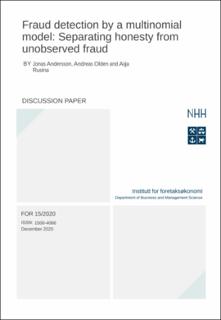Fraud detection by a multinomial model: Separating honesty from unobserved fraud
Working paper

Åpne
Permanent lenke
https://hdl.handle.net/11250/2721233Utgivelsesdato
2020-12-31Metadata
Vis full innførselSamlinger
- Discussion papers (FOR) [566]
Sammendrag
In this paper we investigate the EM-estimator of the model by Caudill et al. (2005). The purpose of the model is to identify items, e.g. individuals or companies, that are wrongly classified as honest; an example of this is the detection of tax evasion. Normally, we observe two groups of items, labeled fraudulent and honest, but suspect that many of the observationally honest items are, in fact, fraudulent. The items observed as honest are therefore divided into two unobserved groups, honestH, representing the truly honest, and honestF, representing the items that are observed as honest, but that are actually fraudulent. By using a multinomial logit model and assuming commonality between the observed fraudulent and the unobserved honestF, Caudill et al. (2005) present a method that uses the EM-algorithm to separate them. By means of a Monte Carlo study, we investigate how well the method performs, and under what circumstances. We also study how well bootstrapped standard errors estimates the standard deviation of the parameter estimators.